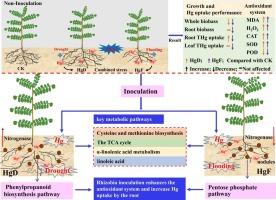在极端水文条件下,根瘤菌共生调节汞积累和代谢适应
IF 11.3
1区 环境科学与生态学
Q1 ENGINEERING, ENVIRONMENTAL
引用次数: 0
摘要
植物修复为减轻汞污染提供了一种可持续的策略,但其在可变水可用性下的有效性仍然知之甚少。以具有显著植物修复潜力的豆科树种刺槐(Robinia pseudoacacia)为研究对象,在接种根瘤菌或不接种根瘤菌的情况下,对汞暴露和水胁迫-干旱(HgD)或洪水(HgF)联合处理下进行了研究。在对照温室研究中,HgD暴露增加了根干生物量,增加了根瘤氮酶活性,促进了根汞的积累,表明了通过根保留来解毒的机制。相反,HgF抑制了植物生长和固氮,减少了总汞吸收,增加了汞向茎部的转运,表明再分配是为了保护根系功能。多组学分析显示,HgD和HgF诱导的基因都参与半胱氨酸和蛋氨酸代谢(如GSS、GCLC、ACS),增强硫醇介导的汞解毒和改变硫分配。l -丝氨酸生物合成持续下调。激素反应出现分化:HgD抑制茉莉酸生物合成(下调AOS、AOC)并降低12-OPDA水平,而HgF激活α-亚麻酸氧化,升高12-OPDA及其衍生物(如秋油酸)。接种根瘤菌进一步提高了根汞潴留,上调了抗氧化酶(SOD, POD),并维持了膜的完整性。在高温下,接种增强了苯丙素代谢(PAL、CCR、CAD的上调),促进了木质素化。在HgF的作用下,它刺激戊糖磷酸途径(通过PFK诱导),优化碳通量,提高应激恢复能力。这些发现表明,在干旱和洪涝条件下,刺槐-根瘤菌共生介导了不同的生理和代谢重编程,从而实现了特定环境下的汞解毒。这突出了罗宾汉作为一个强大的植物修复剂的潜力,在波动的水制度的汞污染的环境。本文章由计算机程序翻译,如有差异,请以英文原文为准。

Rhizobial symbiosis modulates mercury accumulation and metabolic adaptation under hydrological extremes
Phytoremediation offers a sustainable strategy for mitigating mercury (Hg) contamination, yet its efficacy under variable water availability remains poorly understood. Robinia pseudoacacia, a leguminous tree with notable phytoremediation potential, was investigated under combined Hg exposure and water stress—drought (HgD) or flooding (HgF)—with or without rhizobia inoculation. In a controlled greenhouse study, HgD exposure enhanced root dry biomass, increased nodule nitrogenase activity, and promoted root Hg accumulation, indicating a detoxification mechanism via root retention. In contrast, HgF suppressed plant growth and nitrogen fixation, reduced total Hg uptake, and increased Hg translocation to shoots, suggesting redistribution to protect root function. Multi-omics analyses revealed that both HgD and HgF induced genes involved in cysteine and methionine metabolism (e.g., GSS, GCLC, ACS), enhancing thiol-mediated Hg detoxification and altering sulfur allocation. L-serine biosynthesis was consistently downregulated. Hormonal responses diverged: HgD suppressed jasmonic acid biosynthesis (downregulation of AOS, AOC) and reduced 12-OPDA levels, whereas HgF activated α-linolenic acid oxidation, elevating 12-OPDA and its derivatives (e.g., colneleic acid). Rhizobial inoculation further improved root Hg retention, upregulated antioxidant enzymes (SOD, POD), and maintained membrane integrity. Under HgD, inoculation enhanced phenylpropanoid metabolism (upregulation of PAL, CCR, CAD), promoting lignification. Under HgF, it stimulated the pentose phosphate pathway (via PFK induction), optimizing carbon flux for stress resilience. These findings demonstrate that Robinia-rhizobia symbiosis mediates distinct physiological and metabolic reprogramming under drought and flooding, enabling context-specific Hg detoxification. This highlights Robinia’s potential as a robust phytoremediator in Hg-contaminated environments with fluctuating water regimes.
求助全文
通过发布文献求助,成功后即可免费获取论文全文。
去求助
来源期刊

Journal of Hazardous Materials
工程技术-工程:环境
CiteScore
25.40
自引率
5.90%
发文量
3059
审稿时长
58 days
期刊介绍:
The Journal of Hazardous Materials serves as a global platform for promoting cutting-edge research in the field of Environmental Science and Engineering. Our publication features a wide range of articles, including full-length research papers, review articles, and perspectives, with the aim of enhancing our understanding of the dangers and risks associated with various materials concerning public health and the environment. It is important to note that the term "environmental contaminants" refers specifically to substances that pose hazardous effects through contamination, while excluding those that do not have such impacts on the environment or human health. Moreover, we emphasize the distinction between wastes and hazardous materials in order to provide further clarity on the scope of the journal. We have a keen interest in exploring specific compounds and microbial agents that have adverse effects on the environment.
 求助内容:
求助内容: 应助结果提醒方式:
应助结果提醒方式:


